City contours Nuremberg
A touch of Bella Italia
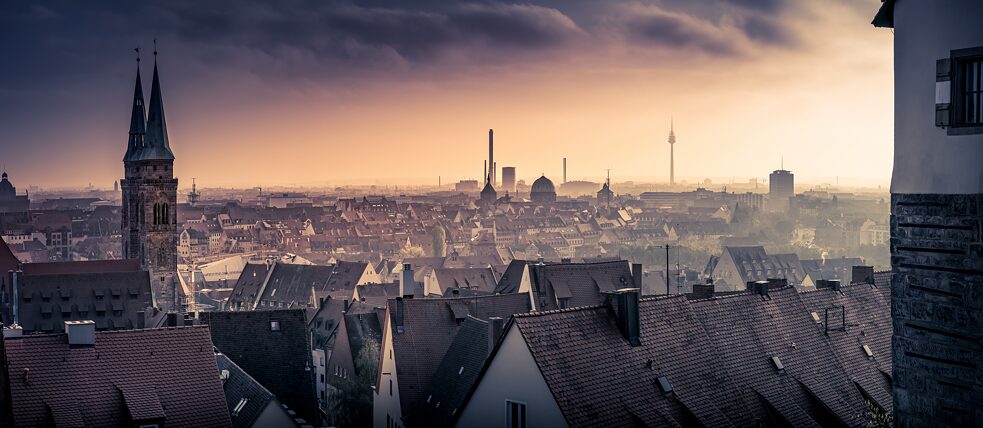
Nuremberg has a picturesque flair and history – including some troubled chapters. The city offers a lot that makes life richer: Our author Clara Lipkowski details spots to experience modern culture, art and curiosities.
By Clara Lipkowski
UNDISPUTED EYE-CATCHER
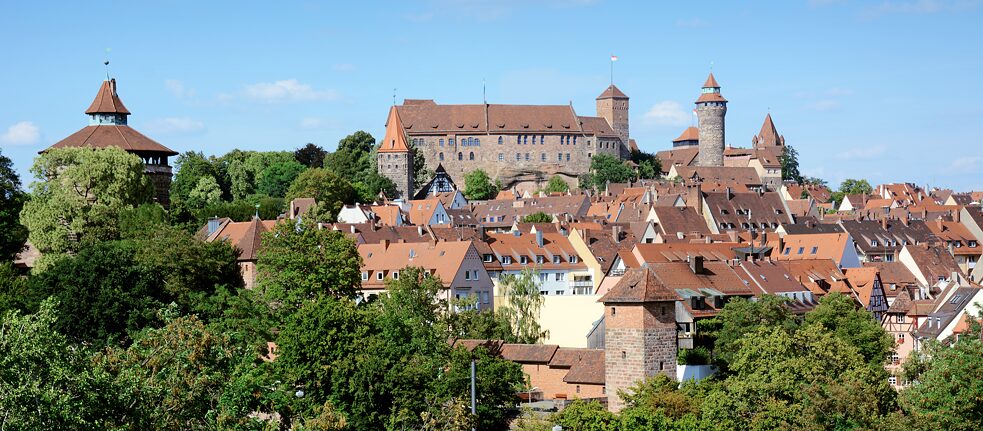 Nuremberg Castle towers over the historic city centre.
| Photo (detail): © Adobe
It is and remains the city’s ultimate head-turner, even if some complain it is just a post-war reconstruction built to replace the original (from the 12th century): the Imperial Castle of Nuremburg. Unlike castles in other cities, it is uniquely centrally located, so it frequently peeks out above the rooftops and behind many street corners as you walk through the city. The castle lookout offers the widest view of the city, so it can get quite crowded with tourists. Slightly tucked away, the castle garden also attracts locals who come here to read or play boules. In the evenings, the alleyways all around the castle are the perfect place for a drink, especially Tiergärtnertorplatz where the bars are built into the hillside. Along Burgstrasse, Nuremberg even has an almost southern European flair. The Old Town Hall, a reconstructed Renaissance building from the 14th century, forms an ensemble with the surrounding buildings that is reminiscent of Bella Italia. The climb up to the castle is worth it just for this view alone.
Nuremberg Castle towers over the historic city centre.
| Photo (detail): © Adobe
It is and remains the city’s ultimate head-turner, even if some complain it is just a post-war reconstruction built to replace the original (from the 12th century): the Imperial Castle of Nuremburg. Unlike castles in other cities, it is uniquely centrally located, so it frequently peeks out above the rooftops and behind many street corners as you walk through the city. The castle lookout offers the widest view of the city, so it can get quite crowded with tourists. Slightly tucked away, the castle garden also attracts locals who come here to read or play boules. In the evenings, the alleyways all around the castle are the perfect place for a drink, especially Tiergärtnertorplatz where the bars are built into the hillside. Along Burgstrasse, Nuremberg even has an almost southern European flair. The Old Town Hall, a reconstructed Renaissance building from the 14th century, forms an ensemble with the surrounding buildings that is reminiscent of Bella Italia. The climb up to the castle is worth it just for this view alone.
Street dance and Schäuferla shoulder to shoulder
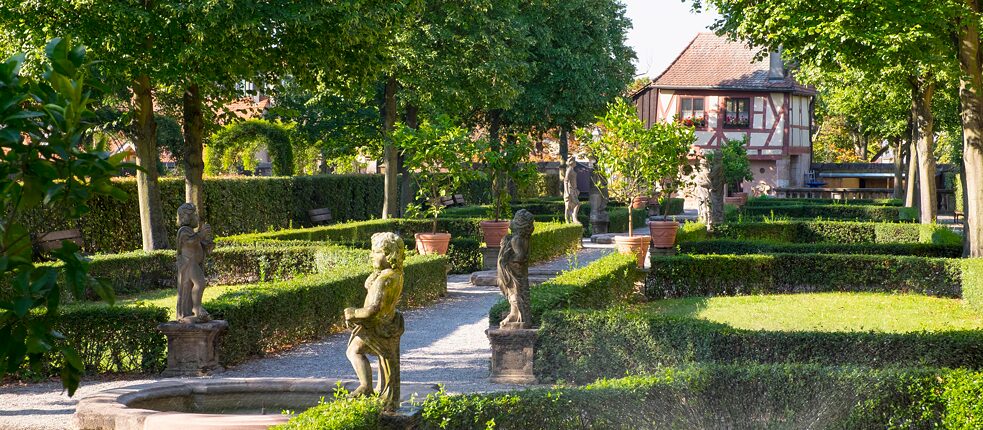 Hidden gem: the Gardens of the Hesperides near the banks of the Pegnitz River.
| Photo (detail): © picture alliance / imageBROKER / Martin Siepmann
Nuremberg is a city that loves its sports. In part, of course, because of the 1st FC Nuremberg, a Bundesliga football club. In the mouths of Franconians, by the by, it sounds more like “glub” than “club”, as the local dialect softens all hard consonants. It is also a sports-loving city because half of Nuremberg meets to work out and to see and be seen on the many athletic fields in the Burggraben and especially along the Pegnitz River. You can jog, skate or cycle several kilometres through the floodplains to neighbouring Fürth, which many refer to as an extension of the city because of its proximity (much to the displeasure of the people of Fürth). Anyone who hasn’t taken the time to watch the basketball players, boxers and street dancers under the Theodor Heuss Bridge has missed out on one of Nuremberg’s key hotspots. Nearby and partially hidden are Hesperidengärten, the Gardens of the Hesperides built in the 16th century. Here the stone nymphs of Greek mythology stand in a row next to an old brush factory. Insiders know the best access is through Barockhäusle Restaurant. Non-vegetarians will enjoy its quintessentially Franconian dish, Schäuferla or pork shoulder with dumplings.
Hidden gem: the Gardens of the Hesperides near the banks of the Pegnitz River.
| Photo (detail): © picture alliance / imageBROKER / Martin Siepmann
Nuremberg is a city that loves its sports. In part, of course, because of the 1st FC Nuremberg, a Bundesliga football club. In the mouths of Franconians, by the by, it sounds more like “glub” than “club”, as the local dialect softens all hard consonants. It is also a sports-loving city because half of Nuremberg meets to work out and to see and be seen on the many athletic fields in the Burggraben and especially along the Pegnitz River. You can jog, skate or cycle several kilometres through the floodplains to neighbouring Fürth, which many refer to as an extension of the city because of its proximity (much to the displeasure of the people of Fürth). Anyone who hasn’t taken the time to watch the basketball players, boxers and street dancers under the Theodor Heuss Bridge has missed out on one of Nuremberg’s key hotspots. Nearby and partially hidden are Hesperidengärten, the Gardens of the Hesperides built in the 16th century. Here the stone nymphs of Greek mythology stand in a row next to an old brush factory. Insiders know the best access is through Barockhäusle Restaurant. Non-vegetarians will enjoy its quintessentially Franconian dish, Schäuferla or pork shoulder with dumplings.
Disturbing past
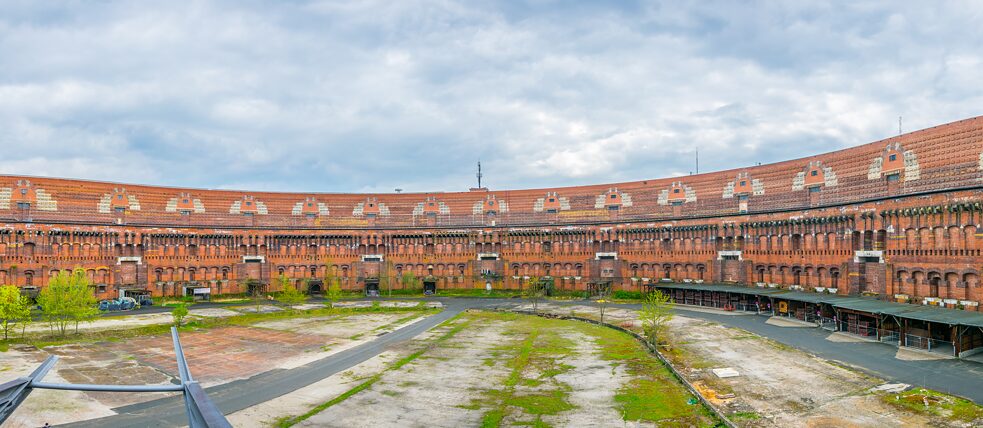 It would have been twice as large as the Colosseum: View of the interior of the planned Congress Hall on the former Reichparteitagsgelände.
| Photo (detail): © Adobe
When visiting Nuremberg, touring the former Reichsparteitagsgelände or Nazi Party Rally Grounds in the southeast of the city, where Adolf Hitler held his major propaganda events during the Nazi era, should be on the agenda. In 1933, Hitler declared Nuremberg the “City of the Nazi Party Rallies”, making it the “Führer’s City” where the architecture was to undergo the appropriate redesign. The Nazi Party Rally Grounds served as a huge deployment area and gigantic stone buildings were erected. Some argue the only way to really understand the megalomania of Nazi architecture is to stand close to these colossal structures at least once. The Congress Hall was designed to be almost twice as large as the Colosseum in Rome and 50,000 people could have attended NSDAP rallies there, if construction hadn’t been abandoned during the war. Debate as to the buildings’ fate – whether they should be preserved and expensively renovated to serve as a warning, allowed to decay, or even be demolished has raged for decades. The idea of opening the space to artists’ studios has recently been floated. In one slightly bizarre twist, the grounds have hosted public festivals, concerts and car races for years now.
It would have been twice as large as the Colosseum: View of the interior of the planned Congress Hall on the former Reichparteitagsgelände.
| Photo (detail): © Adobe
When visiting Nuremberg, touring the former Reichsparteitagsgelände or Nazi Party Rally Grounds in the southeast of the city, where Adolf Hitler held his major propaganda events during the Nazi era, should be on the agenda. In 1933, Hitler declared Nuremberg the “City of the Nazi Party Rallies”, making it the “Führer’s City” where the architecture was to undergo the appropriate redesign. The Nazi Party Rally Grounds served as a huge deployment area and gigantic stone buildings were erected. Some argue the only way to really understand the megalomania of Nazi architecture is to stand close to these colossal structures at least once. The Congress Hall was designed to be almost twice as large as the Colosseum in Rome and 50,000 people could have attended NSDAP rallies there, if construction hadn’t been abandoned during the war. Debate as to the buildings’ fate – whether they should be preserved and expensively renovated to serve as a warning, allowed to decay, or even be demolished has raged for decades. The idea of opening the space to artists’ studios has recently been floated. In one slightly bizarre twist, the grounds have hosted public festivals, concerts and car races for years now.
Left-wing activists and Twitter experts in the trendy district
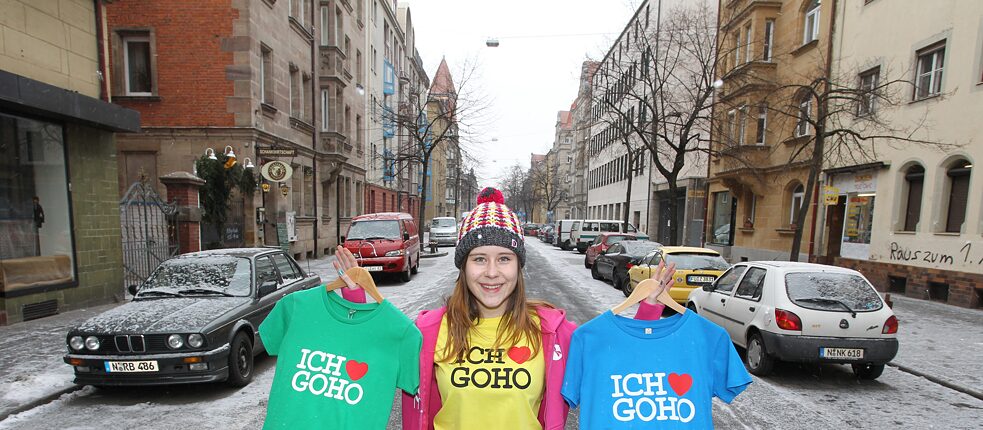 This is Gostenhof: Between pubs and May Day graffiti, a teenager proudly displays her “I love Goho” T-shirt collection.
| Photo (detail): © picture alliance / dpa / Karl-Josef Hildenbrand
The western part of the city, Gostenhof or “GoHo,” as some call it in a play on “SoHo”, is quite colourful, even if it is too small to compare with the trendy neighbourhoods in London and New York. GoHo is a mix of high-income earners living in luxurious, renovated old buildings next to ex-convicts on the dole. Digital agencies have found a place somewhere in between, like “Twitterperlen” who collects the funniest tweets every day and re-tweets them to hundreds of thousands of social media users in Germany. Once a building has been renovated, is it rarely rented out in a socially responsible manner. On Petra Kelly Platz, home to glorious old buildings, a hipster café, a wine bar and ancient computer store stand right next to each other, and just one street away, stores selling Turkish food and other products line the sidewalks, inspiring some people call it “Gostanbul”. Members of the left-wing movement meet in Gostenhof, fear their “their neighbourhood” and protest rising rents, which sometimes results in a rendezvous with police. The annual May Day demonstration also starts in what is likely Nuremberg’s most left-wing district. It too sometimes ends with clashes with law enforcement. A wander through the many hidden courtyards where local flea markets are held is a fun way to spend your time.
This is Gostenhof: Between pubs and May Day graffiti, a teenager proudly displays her “I love Goho” T-shirt collection.
| Photo (detail): © picture alliance / dpa / Karl-Josef Hildenbrand
The western part of the city, Gostenhof or “GoHo,” as some call it in a play on “SoHo”, is quite colourful, even if it is too small to compare with the trendy neighbourhoods in London and New York. GoHo is a mix of high-income earners living in luxurious, renovated old buildings next to ex-convicts on the dole. Digital agencies have found a place somewhere in between, like “Twitterperlen” who collects the funniest tweets every day and re-tweets them to hundreds of thousands of social media users in Germany. Once a building has been renovated, is it rarely rented out in a socially responsible manner. On Petra Kelly Platz, home to glorious old buildings, a hipster café, a wine bar and ancient computer store stand right next to each other, and just one street away, stores selling Turkish food and other products line the sidewalks, inspiring some people call it “Gostanbul”. Members of the left-wing movement meet in Gostenhof, fear their “their neighbourhood” and protest rising rents, which sometimes results in a rendezvous with police. The annual May Day demonstration also starts in what is likely Nuremberg’s most left-wing district. It too sometimes ends with clashes with law enforcement. A wander through the many hidden courtyards where local flea markets are held is a fun way to spend your time.
Internationally renowned courtroom
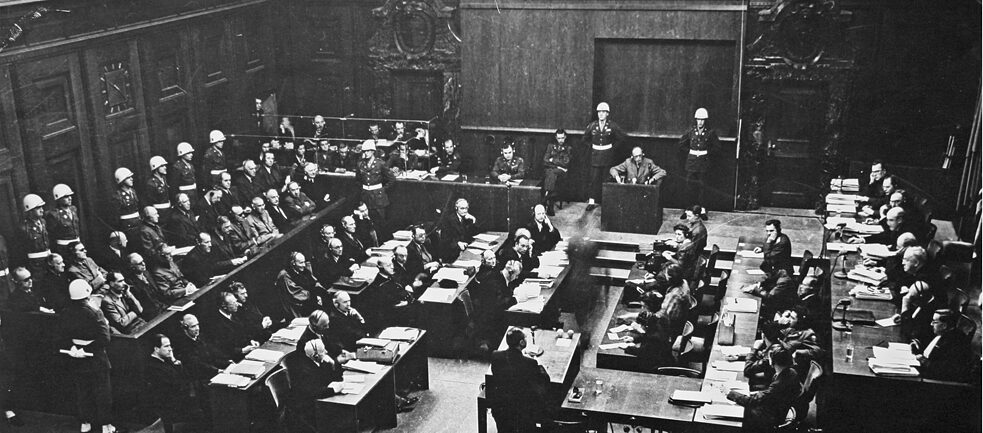 View of the courtroom during the Nuremberg Trials in 1945/46.
| Photo (detail): © picture alliance / ZB / Agentur Voller Ernst
It would not be an exaggeration to say that Courtroom 600 is not only an exceptional site for Nuremberg, but also for world history. The Nuremberg Trials took place here, in the wood-panelled room in the Nuremberg Palace of Justice before the International Military Tribunal starting on November 20, 1945. Leading National Socialists such as Hermann Göring were tried and sentenced here. At the time, the courtroom was extensively upgraded to accommodate the international press and others. The courtroom did not close its doors until March 2020. Today visitors to the site can listen to disturbing audio recordings from the trials and follow the story of the then just 27-year-old US chief prosecutor Benjamin Ferencz, 101 years old now and living in Florida.
View of the courtroom during the Nuremberg Trials in 1945/46.
| Photo (detail): © picture alliance / ZB / Agentur Voller Ernst
It would not be an exaggeration to say that Courtroom 600 is not only an exceptional site for Nuremberg, but also for world history. The Nuremberg Trials took place here, in the wood-panelled room in the Nuremberg Palace of Justice before the International Military Tribunal starting on November 20, 1945. Leading National Socialists such as Hermann Göring were tried and sentenced here. At the time, the courtroom was extensively upgraded to accommodate the international press and others. The courtroom did not close its doors until March 2020. Today visitors to the site can listen to disturbing audio recordings from the trials and follow the story of the then just 27-year-old US chief prosecutor Benjamin Ferencz, 101 years old now and living in Florida.
Nuremberg does public spaces well. Mostly
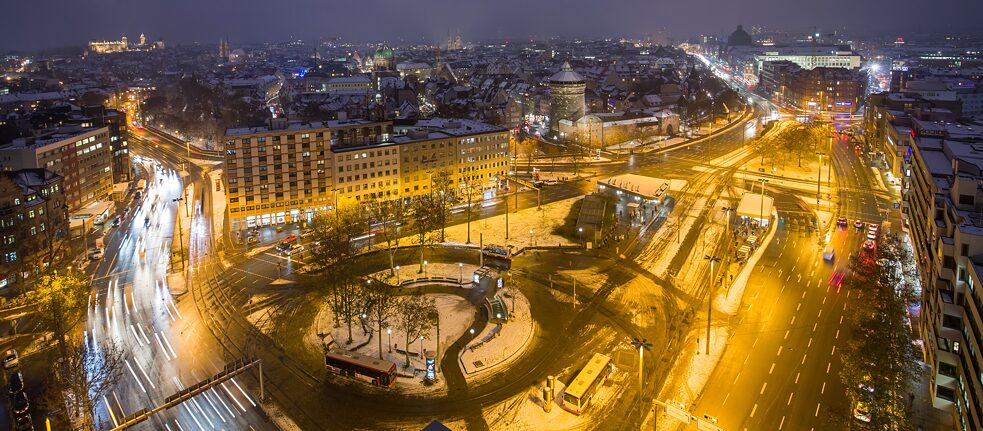 In the bright lights it looks a little less ugly – view of the Plärrer from above.
| Photo (detail): © picture alliance / dpa / Daniel Karmann
Admittedly, not all the squares in Nuremberg are beautiful, and you’d be forgiven for considering the reconstruction after the war only moderately successful. The square at the Weisser Turm or White Tower with its fountain sculpture is considered one of Nuremberg’s ugliest, though the concrete-and-pavement monstrosity the Plärrer gives it a run for its money. It is also a traffic hub where the driverless, fully automatic subway stops – Germany’s first, by the way. Köpfleinsberg Square is close by where, under the war memorial, you can sit on the steps or in cafés like in an Italian piazza. Admittedly modest in size, it boasts one of the most beautiful views of the castle. Believe it or not, a nearby parking garage competes for this honour. Stand on the seventh-floor parking deck of the garage on Adlerstrasse to see the castle its full glory along with the rust-red roofs of the old town glowing in the sun.
In the bright lights it looks a little less ugly – view of the Plärrer from above.
| Photo (detail): © picture alliance / dpa / Daniel Karmann
Admittedly, not all the squares in Nuremberg are beautiful, and you’d be forgiven for considering the reconstruction after the war only moderately successful. The square at the Weisser Turm or White Tower with its fountain sculpture is considered one of Nuremberg’s ugliest, though the concrete-and-pavement monstrosity the Plärrer gives it a run for its money. It is also a traffic hub where the driverless, fully automatic subway stops – Germany’s first, by the way. Köpfleinsberg Square is close by where, under the war memorial, you can sit on the steps or in cafés like in an Italian piazza. Admittedly modest in size, it boasts one of the most beautiful views of the castle. Believe it or not, a nearby parking garage competes for this honour. Stand on the seventh-floor parking deck of the garage on Adlerstrasse to see the castle its full glory along with the rust-red roofs of the old town glowing in the sun.
Hotspots for Nuremberg hipsters
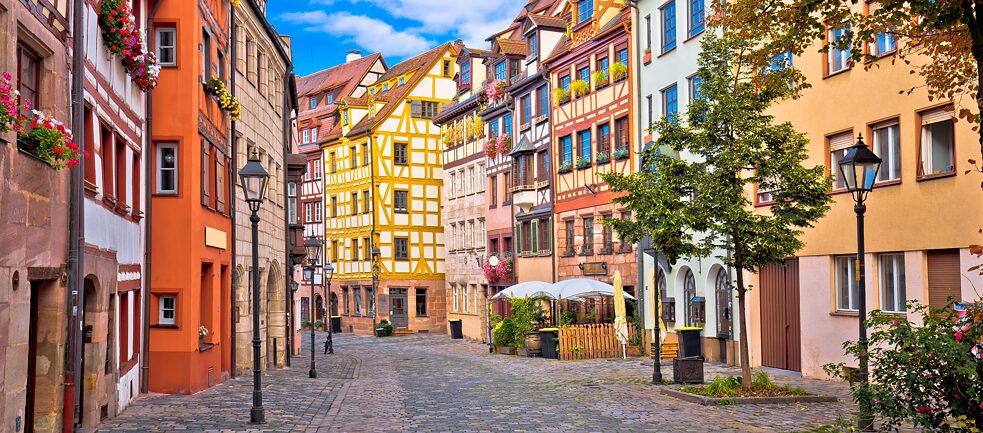 Now would be the time to pull out your smartphone if you enjoy the picturesque: Weißgerbergasse is probably the most photographed place in Nuremberg.
| Photo (detail): © Adobe
Some places in Nuremberg are mainly frequented by hipsters who feel comfortable under naked light bulbs in “industrial look” cafés, like Café Bergbrand. People flock to the corner of Weißgerbergasse to partake in its high-quality coffee at correspondingly high prices. The alleyway itself is lovely, if you like it picturesque, and visitors whip out their smartphones to capture the half-timbered houses, geraniums, cobblestones, slight incline and small stores. It is probably the most photographed corner in Nuremberg. From here many feel the pull of the Hallerwiese with its red deckchairs, absolutely “the” place to be in summer, sometimes crowded with an Ibiza-like party atmosphere. Especially in front of Café Schnepperschütz, built in a former public toilet and the ideal place to enjoy a lager, glass of wine, or an avocado toast.
Now would be the time to pull out your smartphone if you enjoy the picturesque: Weißgerbergasse is probably the most photographed place in Nuremberg.
| Photo (detail): © Adobe
Some places in Nuremberg are mainly frequented by hipsters who feel comfortable under naked light bulbs in “industrial look” cafés, like Café Bergbrand. People flock to the corner of Weißgerbergasse to partake in its high-quality coffee at correspondingly high prices. The alleyway itself is lovely, if you like it picturesque, and visitors whip out their smartphones to capture the half-timbered houses, geraniums, cobblestones, slight incline and small stores. It is probably the most photographed corner in Nuremberg. From here many feel the pull of the Hallerwiese with its red deckchairs, absolutely “the” place to be in summer, sometimes crowded with an Ibiza-like party atmosphere. Especially in front of Café Schnepperschütz, built in a former public toilet and the ideal place to enjoy a lager, glass of wine, or an avocado toast.
Upcycled by creative minds
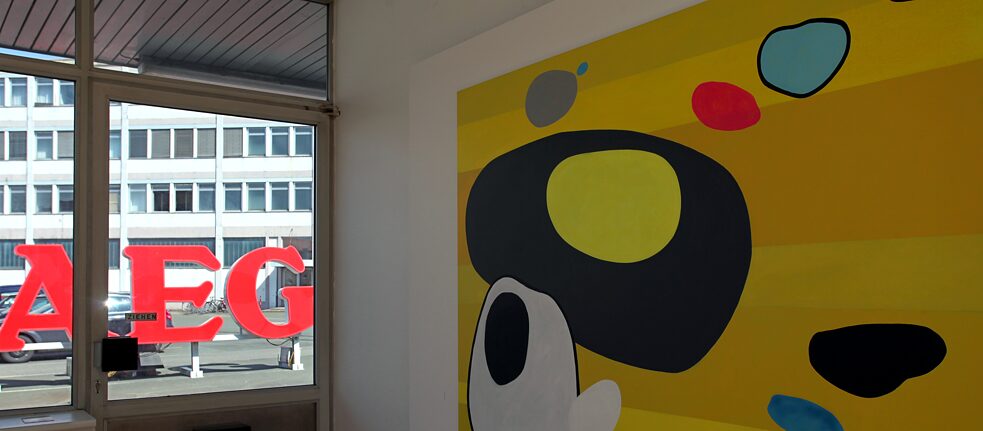 Art is on display “at AEG”.
| Photo (detail): © picture alliance / dpa / Daniel Karmann
As the second largest city in Bavaria – home to half a million people at any rate – Nuremberg is often referred to as Munich’s “little sister”. But Nuremberg is packed with cultural locales with their very own charm. Following the catastrophic bankruptcy of a few large companies in the past, the creative have sized the abandoned factory sites. After years of protests, the AEG electrical company, for example, closed its plant with 1,700 jobs in 2006, which hit the city pretty hard. But then fashion designers, sculptors and other artists rented cheap space in an old AEG building and opened their doors to show their art “on AEG”. They have since had to give way to the city’s plans to establish a technical university in the space. A short trip is worthwhile, however, to see the well-preserved old factory flair.
Art is on display “at AEG”.
| Photo (detail): © picture alliance / dpa / Daniel Karmann
As the second largest city in Bavaria – home to half a million people at any rate – Nuremberg is often referred to as Munich’s “little sister”. But Nuremberg is packed with cultural locales with their very own charm. Following the catastrophic bankruptcy of a few large companies in the past, the creative have sized the abandoned factory sites. After years of protests, the AEG electrical company, for example, closed its plant with 1,700 jobs in 2006, which hit the city pretty hard. But then fashion designers, sculptors and other artists rented cheap space in an old AEG building and opened their doors to show their art “on AEG”. They have since had to give way to the city’s plans to establish a technical university in the space. A short trip is worthwhile, however, to see the well-preserved old factory flair.
The Quelle mail order company went bankrupt in 2009, and today the “Quell-Kollektiv”, a bunch of creative people who organise lectures and discussion nights, meets in the boiler house in Quelle Park. And Nuremberg is rich in culture in other ways, too. Once you’ve seen the modern choreographies of Goyo Montero, you will probably no longer feel the urge to go to Munich to experience impressive contemporary art. The Germanisches Nationalmuseum is the largest museum of cultural history in the German-speaking world. Then there is the Neues Museum, which shows modern art housed in a glass building designed by Volker Staab, an architectural must-see. The “Future Museum” is currently being built, an offshoot of Munich’s Deutsches Museum – fine, we’ll concede that point to the state capital. The museum is not entirely uncontroversial, as the Free State has been accused of paying far too much rent for it. But apart from that, Nuremberg is definitely worth a look when it comes to culture.
Bridges, bridges, and more bridges
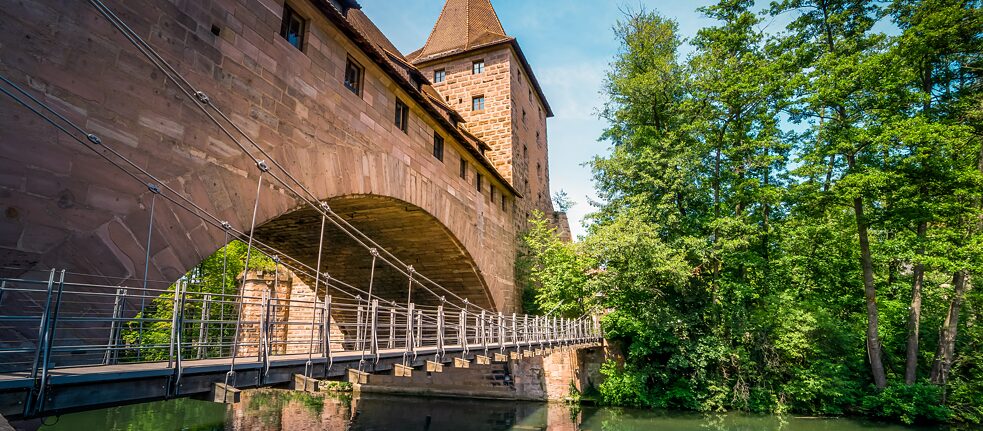 Probably the most romantic bridge in the city, the Kettensteg is said to be the oldest chain bridge in continental Europe.
| Photo (detail): © Adobe
The Pegnitz River meanders through the historic city centre and the people of Nuremberg linger at many places along its banks with an aperitif or a beer. Life practically takes place at and on the sometimes more, sometimes less beautiful bridges. Trödelmarkt Island, for example, is a nice place to dangle your feet in the water. While Henkersteg or Hangman’s Bridge is generally considered a highlight, Kettensteg is even more romantic and supposedly the oldest existing chain bridge in continental Europe. It is lit up in the evenings when the water and the historic old town houses built along the river seem to glow.
Probably the most romantic bridge in the city, the Kettensteg is said to be the oldest chain bridge in continental Europe.
| Photo (detail): © Adobe
The Pegnitz River meanders through the historic city centre and the people of Nuremberg linger at many places along its banks with an aperitif or a beer. Life practically takes place at and on the sometimes more, sometimes less beautiful bridges. Trödelmarkt Island, for example, is a nice place to dangle your feet in the water. While Henkersteg or Hangman’s Bridge is generally considered a highlight, Kettensteg is even more romantic and supposedly the oldest existing chain bridge in continental Europe. It is lit up in the evenings when the water and the historic old town houses built along the river seem to glow.
Beach in the city and other quirks
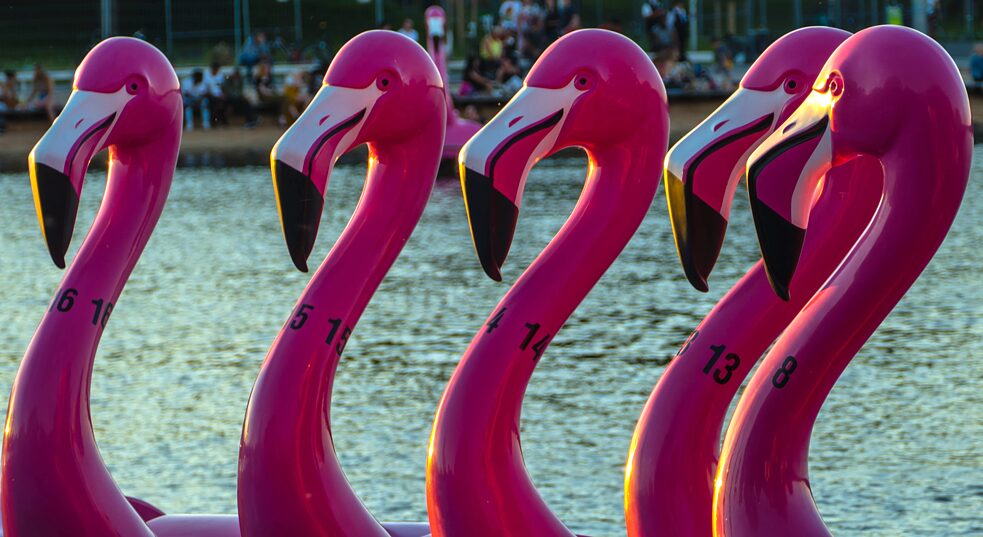 Markus Söder wanted a beach and he got a beach – and a whole fleet of flamingo pedal boats in the bargain.
| Photo (detail): © Adobe
It was nothing less than a “project close to my heart,” Bavarian Prime Minister Markus Söder likes to emphasize when he starts talking about Wöhrde Lake. And you’ve got to give him his due – the CSU politician and well-known Nuremberg resident has made the lake more beautiful. The Pegnitz River was originally dammed here to keep floodwaters from flowing into the historic city centre, now it’s a nice place to swim. Markus Söder decided he wanted beach and he got a beach. He never tires of emphasizing everything he does for Nuremberg (he brought Bavarian ministries to the city, though the Future Museum was also his doing). 30 million euros went into the lake improvement, flattening out the steep banks and adding an illuminated panorama pier, all of which went over pretty well. When Söder once again announces his involvement in Instagram posts or Tweets, the people of Nuremberg take it with typical, Franconian serenity. The city has given rise to so many things: Nuremberg bratwurst, gingerbread, Albrecht Dürer, and now a prime minister who is a weng eigen or just a bit eccentric.
Markus Söder wanted a beach and he got a beach – and a whole fleet of flamingo pedal boats in the bargain.
| Photo (detail): © Adobe
It was nothing less than a “project close to my heart,” Bavarian Prime Minister Markus Söder likes to emphasize when he starts talking about Wöhrde Lake. And you’ve got to give him his due – the CSU politician and well-known Nuremberg resident has made the lake more beautiful. The Pegnitz River was originally dammed here to keep floodwaters from flowing into the historic city centre, now it’s a nice place to swim. Markus Söder decided he wanted beach and he got a beach. He never tires of emphasizing everything he does for Nuremberg (he brought Bavarian ministries to the city, though the Future Museum was also his doing). 30 million euros went into the lake improvement, flattening out the steep banks and adding an illuminated panorama pier, all of which went over pretty well. When Söder once again announces his involvement in Instagram posts or Tweets, the people of Nuremberg take it with typical, Franconian serenity. The city has given rise to so many things: Nuremberg bratwurst, gingerbread, Albrecht Dürer, and now a prime minister who is a weng eigen or just a bit eccentric.